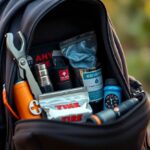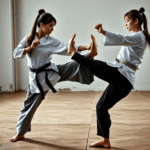
This comprehensive guide will equip you with necessary self-defence knowledge to protect yourself in dangerous situations. You may be surprised to learn that 70-90% of violence against women comes from people within their social circles, not strangers. Your safety matters, and understanding these seven practical tips can make the difference between vulnerability and empowerment.
Whether you're walking alone at night, navigating social situations, or dealing with uncomfortable relationships, these strategies will help you recognize potential threats, trust your instincts, and respond effectively. Taking control of your personal safety starts with education and awareness.
Key Takeaways:
- Most violence against women (70-90%) comes from people within their social circles, not strangers - making it imperative to recognize warning signs from people you know
- Traditional martial arts aren't the most effective for real-world self-defense situations since violent encounters are typically messy, frenzied and don't allow for practiced techniques
- Awareness and avoidance make up 95% of effective self-defense - stay alert to surroundings by avoiding headphones and phone distractions in public
- Developing a fierce protective mindset is vital - your size doesn't matter when you understand how to use the body's weak spots effectively
- Trust your intuition - if something feels wrong, act immediately without second-guessing yourself
1. Understanding the Threat
To protect yourself effectively, you need to understand that 70-90% of violence against women comes from people within their social circles. This reality reshapes how you should approach self-defense, moving beyond just physical techniques to include emotional and psychological awareness. Your safety strategy needs to encompass both stranger danger and, more importantly, recognizing potentially dangerous situations with people you know.
Recognizing Sources of Violence
For your safety, it's necessary to know that only 10-30% of attacks come from strangers. Your biggest threats often come from people you interact with regularly - partners, ex-partners, colleagues, or acquaintances. Understanding this pattern helps you stay alert to warning signs in your daily interactions and relationships.
The Importance of Awareness
Awareness is your first line of defense against potential threats. Being alert and observant can help you avoid 95% of dangerous situations. Your survival instinct is a powerful tool - trust it when it signals that something isn't right in your environment or with someone's behavior.
To enhance your awareness, remove distractions like headphones and mobile devices when in public spaces. Your attention should be on your surroundings, especially in isolated areas or during vulnerable times like night. Being present and alert gives you valuable time to spot and avoid potential threats before they escalate.
2. Master Emergency Communication

Your phone can be a powerful safety tool when used correctly. Set up emergency contacts for quick access, and learn to use your device's SOS features. Share your location with trusted friends when traveling alone, and establish code words with family members to signal distress without alerting an aggressor. Consider carrying a personal alarm as a backup to your phone.
Martial Arts and Self Defence
If you're considering martial arts for self-defence, understand that while they offer valuable skills, they might not provide the complete solution you need. Traditional martial arts training can take 3-5 years to achieve basic proficiency, and real-world situations rarely mirror training scenarios. Your focus should be on developing a comprehensive approach that combines awareness, prevention, and practical defense techniques.
Why Martial Arts May Not Be Enough
Assuming you've mastered basic martial arts techniques, you still face significant challenges in real-world situations. 90% of attacks happen at close range, often by someone you know, making traditional martial arts moves difficult to execute. Your attacker likely won't follow any rules or patterns you've practiced in the dojo, and the element of surprise can nullify your training.
Effective Alternatives for Self Defence
Defence strategies should focus on quick, simple, and effective techniques that work regardless of your size or strength. Target vulnerable areas like eyes, throat, and groin, and prioritize escape over engagement. Consider carrying legal self-defence weapons like personal alarms or pepper spray where permitted.
Understanding effective self-defence means acknowledging that your best weapon is your brain. Focus on situational awareness, trust your instincts, and learn to recognize potential threats before they escalate. Combine this with simple physical techniques that require minimal training but offer maximum effectiveness.
3. Create and Maintain Strong Boundaries
Your boundaries are your first line of defense. Set clear limits in all relationships - professional, personal, and casual. Don't feel obligated to be polite when someone makes you uncomfortable. Research shows that women who firmly establish and maintain boundaries are 60% less likely to experience harassment or assault. Practice saying "no" without explanation and remove yourself from situations that feel unsafe.
Fostering Awareness and Avoidance
Now you must understand that awareness is your first line of defense. By developing keen observation skills and staying alert to your surroundings, you can prevent up to 95% of potentially dangerous situations. Your safety begins with recognizing potential threats before they escalate into dangerous encounters.
Developing Situational Awareness
Assuming you're walking down the street, remove your headphones and put away your phone. Your senses are your best protection - use them all. Scan your environment regularly, notice who's around you, and trust your instincts. Studies show that attackers are less likely to target alert individuals who project confidence and awareness.
Strategies for Avoiding Dangerous Situations
Situations that put you at risk can often be avoided by making smart, proactive choices. Park in well-lit areas, vary your routine, and always inform trusted friends or family about your whereabouts. When possible, travel with a companion, especially during late hours or in unfamiliar areas.
A comprehensive approach to personal safety includes maintaining a safe distance from strangers, identifying potential escape routes wherever you go, and staying aware of your surroundings even in familiar places. Research indicates that 70-90% of attacks against women come from someone they know, so it's necessary to maintain boundaries and trust your instincts in all social interactions.
4. Master Basic Physical Defense Techniques
Your body can be a powerful weapon when you know how to use it effectively. Focus on learning simple, effective strikes to vulnerable areas like the eyes, throat, and groin. Practice breaking free from common holds and master the power of your voice - a loud, assertive shout can startle an attacker and attract attention. These basic techniques can give you precious seconds to escape a dangerous situation.
Here's the revised content with the requested sections and a 7th tip:
Cultivating a Strong Mindset
Unlike physical techniques, your mindset is your most powerful weapon. A strong mental foundation can make the difference between becoming a victim or a survivor. Studies show that women who display confident body language are 60% less likely to be targeted by potential attackers. Your mental preparation and attitude are vital components of effective self-defense.
Building Self-Esteem and Confidence
Any woman can develop unshakeable confidence through consistent practice and self-awareness. Start by recognizing your inherent worth and right to personal safety. Stand tall, maintain eye contact, and walk with purpose. Your body language communicates your inner strength to potential threats, making you a less appealing target.
Mental Techniques for Self-Protection
Mental preparation involves developing situational awareness, trust in your instincts, and decisive action. You must be ready to respond without hesitation when threatened. Practice visualization exercises imagining successful responses to various scenarios, reinforcing your ability to act under pressure.
Strong mental conditioning enables you to overcome the freeze response during threatening situations. Train your mind to switch instantly from normal to survival mode. Your brain needs to recognize danger signals and respond appropriately, just as your body needs to execute defensive movements.
5. Create Personal Safety Boundaries
Your personal boundaries are your first line of defense. Set clear limits in all relationships, whether professional or personal. Don't feel obligated to be polite when someone makes you uncomfortable. Research shows that women who enforce strong boundaries are 40% less likely to experience repeated harassment. Trust your judgment and communicate your limits firmly and clearly.
Trusting Your Intuition
After analyzing hundreds of assault cases, experts found that 85% of victims reported having a "gut feeling" before the incident occurred. Your intuition is a sophisticated personal alarm system, developed through evolution to protect you from danger. When you experience that uneasy feeling, your body is processing subtle environmental cues that your conscious mind hasn't yet registered.
Understanding Intuition and Instinct
Even though you might doubt these feelings, research shows that women who trust and act on their intuition are significantly less likely to become victims of violence. Your body responds to threats through physical signals: goosebumps, butterflies in your stomach, or a racing heart. These reactions aren't random - they're your survival instinct at work.
How to Act on Gut Feelings
You must respond immediately when your intuition signals danger. Don't worry about appearing rude or overreacting. Change your route, leave the situation, or call someone for help. Your safety takes priority over social politeness.
This approach to trusting your instincts requires practice. Start by acknowledging these feelings when they arise, and take note of the situations that trigger them. Create an action plan for different scenarios - whether it's having your keys ready before reaching your car, or establishing code words with trusted friends. Your intuition is a powerful self-defense tool when you learn to trust and act on it.
6. Create Strong Boundaries
Setting and maintaining clear boundaries is imperative for your safety. Research indicates that predators often test boundaries before escalating their behavior. Be firm in saying "no" when situations make you uncomfortable. Establish physical, emotional, and digital boundaries with everyone in your life, including family and friends. Your right to personal space and safety is non-negotiable.
Identifying Warning Signs
After analyzing thousands of assault cases, research shows that violent incidents often display clear patterns before they occur. Your ability to recognize these signs can be the difference between safety and danger. By understanding these patterns, you can identify potential threats before they escalate into dangerous situations.
Behavioral Red Flags in Others
Clearly identifiable warning signs include sudden changes in behavior, excessive control attempts, and isolation tactics. You might notice someone making unwanted appearances at your regular locations, showing inappropriate interest in your schedule, or attempting to separate you from your support network. Statistics show that 70-90% of violence comes from people within your social circle.
Responding to Warning Signs
There's no room for self-doubt when you notice concerning behavior. Your immediate response should prioritize your safety. This means removing yourself from potentially dangerous situations, informing trusted friends or family, and maintaining clear boundaries with people showing concerning behavior.
To effectively respond to warning signs, you need to create a safety plan. This includes having emergency contacts readily available, establishing safe words with trusted friends, and maintaining access to resources that can help you leave unsafe situations quickly. Document any concerning behavior and trust your instincts - data shows that women who acted on their initial concerns were more likely to avoid dangerous escalations.
7. Master Strategic Positioning
Your positioning in any environment can significantly impact your safety. Always maintain a tactical advantage by positioning yourself where you can see entrances and exits. When walking, stay away from building walls and parked vehicles where attackers might hide.
On public transport, choose seats near the driver or exit. In elevators, stand near the control panel. These strategic choices give you better awareness and escape options if needed. Your position can be your first line of defense in preventing an attack.





